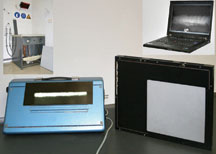
Digital Detector Arrays
The importance of digital detector array technology is increasing as industry continues its transition from film radiography to the digital realm. Subcommittee E07.01 on Radiology (X and Gamma) Method, part of ASTM International Committee E07 on Nondestructive Testing, has recently approved the following three new standards that will aid users in the film-to-digital transition:
These three new standards join the previously approved E2597, Practice for Manufacturing Characterization of Digital Detector Arrays, to form a complete and comprehensive information source for users and manufacturers of digital detector arrays.
"This cadre of standards is necessary for the industry segments that are aggressively moving from film radiography to the digital world," says Trey Gordon, Boeing Research and Technology, and chairman, E07.01. "As a greater number of systems come into use, these standards will assist, educate and inform the users and manufacturers on how a given DDA can be used in a target application. The publication of these standards is a major leap in the advancement of digital radiography."
The four standards represent a complete and comprehensive information source for users and manufacturers. The overall structure of the standards is similar to the current standards for film radiography, radioscopy or computed radiography. These standards:
- Assist manufacturers with the standardization of measurements and reporting of DDA properties that help users make informed purchasing decisions;
- Assist user introduction of the DDA technology into their operations for almost any inspection application; and
- Provide tests and methods to establish and track baseline performance.
E2597 serves as a starting point for the end user to select a DDA for a specific application. DDA manufacturers and system integrators will provide DDA system performance data using standardized geometry, X-ray beam spectra and phantoms as prescribed in this standard. The end user will look at these performance results and compare DDA metrics from various manufacturers to decide on a DDA system that can meet the specification required for inspection.
E2736 is intended to assist the user in understanding the definitions and corresponding performance parameters used in related standards in order to make an informed decision on the purchase and use of a DDA for a given target application. E2736 will help an end user understand technology choices and data acquisition options, and what impact these choices/options might have on imaging performance.
E2698 will assist end users in establishing the minimum requirements for radiological examination using the acquired DDA. The basis of this standard is E1742, Practice for Radiographic Examination, which is a very commonly used standard for film.
E2737 will help the end user in confirming that the DDA system performs as required and is stable in its performance over its lifetime. The standard defines the basic DDA system parameters, the tests that are required to measure them and two different tools for the set of tests.
To purchase ASTM standards, visit www.astm.org and search by the standard designation number, or contact ASTM Customer Relations (phone: 610-832-9585).
CONTACT Technical Information: Trey Gordon, Boeing Research and Technology • Seattle, Wash. • Phone: 206-544-0327 • E-mail: trey.gordon@boeing.com O ASTM Staff: George Luciw • Phone: 610-832-9710 • E-mail: gluciw@astm.org O Upcoming Meeting: Jan. 23-27, 2011 • Plantation, Fla.
 SN Home
SN Home Archive
Archive Advertisers
Advertisers Masthead
Masthead RateCard
RateCard Subscribe
Subscribe Email Editor
Email Editor